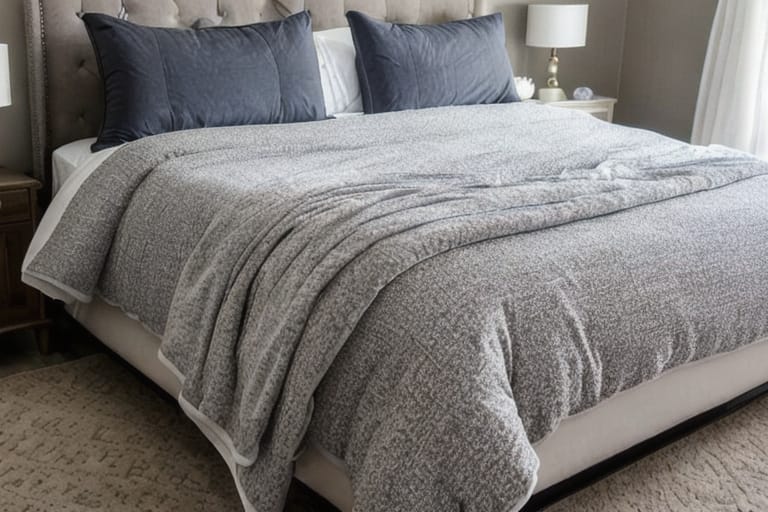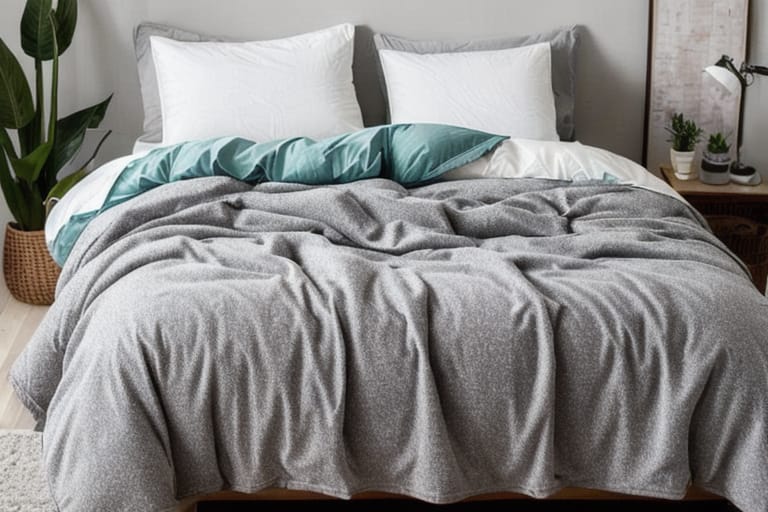When it comes to bedding comfort and warmth, down comforters are hard to beat. Yet some worry that their loosely woven casing may allow tiny particles like dust, dander, or mold spores to escape, triggering allergy problems.
So do down comforters really cause more dust and allergic reactions? Or are the concerns overblown? This beginner’s guide examines the evidence.
How Down Bedding Works
Down comforters are filled with the fine, fluffy clusters of feathers from ducks and geese known as down fill. This natural fill provides unmatched warmth and breathability.
The fill is contained within a Stitch-through box construction of a bedding material like cotton, preventing it from shifting around inside. Still, some particles may escape through minute openings.
Do Down Comforters Cause More Dust?
Some claim that down comforters release more microscopic particles into the air, creating dust that aggravates allergies.
Bedding materials like down are thought to provide an ideal environment for dust mites. The warm, damp conditions caused by body heat and moisture allow these microscopic bugs to thrive and reproduce.
As dust mites feed on skin cells, they also release droppings that contain allergen proteins. When down bedding moves, these particles may get kicked up into the air.
However, there is little evidence showing a clear link between down bedding and dust. In fact, one 2022 study in the Annals of Allergy, Asthma & Immunology found no difference in dust mite allergen levels between down and synthetic comforters.
So while loose particles may escape through the casing over time, down comforters do not appear to generate more dust than other bedding options when cared for properly.
Can Down Bedding Trigger Allergies?
Some people do report aggravation of allergy or asthma symptoms from sleeping under down bedding:
- Runny, congested nose
- Sneezing fits
- Itchy skin or eyes
- Wheezing or coughing
But down itself does not contain proteins that typically trigger allergies. Rather, pre-existing sensitivities may get aggravated by particles like:
- Dust mites and droppings
- Mold or mildew that grows in damp conditions
- Saliva, skin cells, or feathers from birds
- Dander from humans or pets
For those with feather allergies specifically, switching to a synthetic down alternative may provide relief by eliminating direct contact with bird proteins.

Tips to Reduce Dust and Allergens in Down Bedding
While the link between down comforters and worsening allergies is inconclusive, you can take steps to minimize particles, dust, and allergens:
- Wash the down comforter frequently using the warmest recommended water setting and mild detergent to kill dust mites. Consider using an allergen spray first.
- Make sure the comforter dries fully before remaking the bed, as moisture allows mold and mildew growth.
- Fluff and shake the down comforter outside every few weeks to air it out and release any loose particulate matter.
- Use a duvet cover around the comforter to provide an extra barrier against dust and allergens.
- Wash all bed linens weekly in hot water to control dust mites and remove dead skin cells before they accumulate.
- Consider using mattress and pillow encasements to seal out irritants.
- Use a HEPA air purifier in the bedroom to filter airborne particles.
- Apply dust-mite spray to the mattress and wash all bedding frequently in hot water to kill them.
Pros and Cons of Down Bedding
| Pros | Cons |
|---|---|
| Lightweight, impressive warmth-to-weight ratio | Expensive upfront cost |
| Breathable, less risk of overheating | Requires special care when washing |
| Hypoallergenic when cared for properly | May trigger allergies if dust mites or mildew accumulates |
| Long-lasting when cared for | Loose down requires refluffing regularly |
| Natural fill appeals to many | Slight off-gassing odor initially |
So while down comforters have some potential drawbacks related to allergies, proper care reduces these risks substantially.
Top-Rated Down Comforters
Budget Pick: LINENSPA All-Season White Down Comforter
- $60 to $140
- Shell: 300 thread count cotton
- Hypoallergenic
- Machine washable
- Box stitch construction
- 3 sizes available
Premium Pick: Buffy Cloud Down Comforter
- $$170 to $330
- Shell: Eucalyptus derived Tencel lyocell
- Improved fill power and breathability
- Recycled water bottle fill
- 10-year warranty

Alternatives to Down Bedding
For those with feather allergies, synthetic down alternatives provide warmth without the allergy risk:
- Polyester fiberfill mimics properties of down
- Microfiber fill for warmth at lower cost
- Cotton comforters: Warm yet breathable
- Wool fill comforters: Moisture-wicking, antimicrobial properties
Frequently Asked Questions
Do down comforters make dust worse?
While a common belief is that down bedding releases more microscopic particles that contribute to dust, recent medical studies found no difference in measured dust mite allergens between down and synthetic comforters when cared for properly. Still, some allergens may escape through the outer casing over time.
What causes down comforters to make you cough?
Allergic reactions like coughing can occur if dust mites, mold spores, feather particles or other allergens are inhaled after escaping through the comforter’s loosely woven fabric. Asthma symptoms can also worsen. Focus on prevention through duvet covers, hot washing, and air purification.
Are down alternative comforters good for allergies?
Yes, down alternative comforters with polyester or cotton fill eliminate contact with bird proteins that trigger feather allergies. They can still collect dust over time, so allergy prevention steps are still important. Ultimately, synthetic comforters pose less inherent allergy risk.
Why am I suddenly allergic to my down comforter?
Sudden down comforter allergies often stem from dust mites or mold building up unnoticed over time in the warm, damp conditions inside the comforter. Then shaking the bedding releases the trigger. Prevent this through regular fluffing & washing and extra barriers like duvet covers.
Can you be allergic to detergent and down?
Yes, reactions can occur from either the down fill itself or residues left behind by scented detergents. Try an extra rinse cycle, sensitive skin detergent, or liquid allergy-free detergents to prevent this. White vinegar in the wash and dryer can also help fully eliminate residues.
Should you store down comforters in plastic bags?
No – plastic traps in moisture creating an ideal environment for potentially problematic mold growth. Instead, store cleaned comforters in breathable cotton cases. Adding cedar blocks can help absorb moisture and repel insects.
How often should you wash a down comforter?
Experts recommend washing down comforters at least 2-3 times per year to prevent allergen and dust mite buildup. Air them out outdoors monthly, use duvet covers, and wash other bedding weekly as extra protection against particle inhalation between deeper cleanings.








